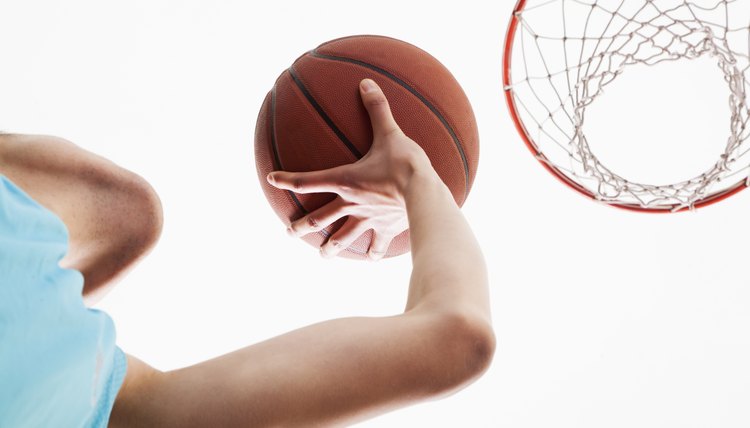How to Jump Higher to Slam Dunk

Dunking a basketball is one of the most challenging physical activities you can do. Regulation basketball goals are 10 feet high and you must jump well over 10 feet in order to slam home a dunk. Players wishing to dunk a basketball must improve their jumping or leaping ability. Improving jumping can come from a variety of strengthening and fitness exercises for your legs and lower body.
Lift weights for your legs to gain strength and explosiveness in your lower body. Lifting weights increases strength and range of motion in the muscles. The idea is that you will increase your power and explosiveness without sacrificing flexibility. Lower body lifts include squats, deadlifts, leg presses, lunges, leg extensions and leg curls.
Stretch your legs to increase flexibility, since a lack of flexibility can lead to injuries and not reaching your athletic potential. Stretching loosens your muscles and allows them to perform better through a greater range of motion. That means they are stronger and able to function better. Combining standard static stretching with dynamic stretches. Incorporate dynamic stretches -- stretches that gently move your joints through their range of motion -- into your warm up, and focus on static stretches -- or held stretches -- after the main portion of your workout.
Add plyometric jumping exercises to your training regimen. Plyometrics refer to explosive jump training and movements like depth jumps, box jumps and bounding. Depth or squat jumps are one of the best ways to increase your vertical leap. They are performed by squatting as deep as you can until your butt nearly touches the floor. Then you simply explode up and leap as high as you can before landing and immediately going into another depth jump. These explosive jumping drills train the body by forcing the legs into jumping positions to make them stronger.
Isolate the calf muscles by performing toe raises and using jump training shoes. Toe raises involve standing with only your toes on a step or platform and rising up as high as you can on your toes and holding the peak position before returning to the starting point. Toe raises are one of the few ways you can isolate your calves in training. Jump training shoes also enable you to isolate your calf and can be worn for training or sport-specific activities. These shoes have a platform on the front sole so that you are forced to be on your toes and no weight is on your heels. That means your calves are forced to support your entire body weight and are isolated throughout every movement.
Add weighted resistance to your calf and plyometric training as you gain strength and power. Eventually your legs will become stronger and non-weighted activities can become easy for you. To continue to improve and jump higher adding ankle weights and or holding weights while training can increase strength and power even more.
Tips
Building the height of your vertical jump takes time. Plan on training for at least six weeks before you see noticeable improvements in your jumping ability.
Warnings
Because plyometric training places great demands on your muscles and joints, only do plyometric training one or twice a week.
References
Writer Bio
Based in Harker Heights, Texas, Timothy Onkst has been writing about sports, fitness and health since 2003. His articles have appeared in a variety of publications including "Texas Roundball" magazine, Yahoo Sports, Fox Sports and other websites.
